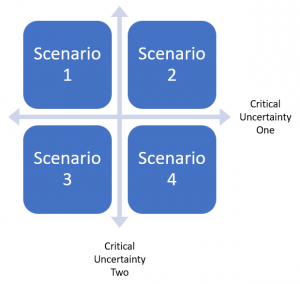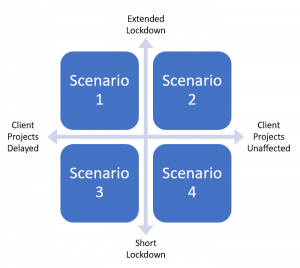An introductory guide to using scenario planning for smaller businesses
During a recent workshop with a client I was once again reminded of the usefulness of scenario planning. I thought it was a great time to reshare a really simple model you can use in your business to try and plan for the future.
In summary, scenario planning is an admission that the future is uncertain. And whilst that is always the case, lots of businesses are feeling the pressure more than ever – struggling with recruitment or retention, contemplating their growth and of course hyper aware of the horrifying situation between Russia and Ukraine. But by identifying specific uncertainties – or different realities – and how they might affect future business operations, scenario planning enables you to become better at making strategic decisions and avoid two pitfalls: underprediction, and overprediction.
There’s a tendency for business leaders to panic about every variable that might affect their business, but by getting to the nub of the problem using the model below, you can at least feel comforted that you are ready to make decisions based on future happenings.
Background: This framework became popular in large corporates in the 1970s. There have been many academic articles written about the subject with many of them focusing on how large organisations overcome the complexities of planning and forecasting. But amongst all this writing, there are a few principles that underpin the whole topic. It is these core principles that are useful for any organisation and can be easily applied when looking at planning and forecasting.
The ABC of scenario development: your planning should be very simple:
- Define your critical uncertainties
- Develop plausible scenarios to allow you to discuss impact and responses to each one
In short, work out what could happen and what you’d do about it. It doesn’t ask you to be a fortune teller and predict the future – but it does help you focus on the most likely, and most impactful, scenarios that your organization might face.
Putting it into practice – Four Step Scenario Development
As the name suggests, there are four discrete components to this approach:

- Identify your driving forces: define the big shifts in society, technology, politics and so on that will affect your company
- Identify your critical uncertainties: select two of those driving forces that will have a critical impact on your business
- Develop a range of plausible scenarios: by plotting your critical uncertainties onto a simple two axis matrix – this will give you four scenarios to consider
- Discuss the implications: of each scenario and work out what the implications are for you and how you would respond to each.
An example of scenario planning – Planning around Covid-19 scenarios:

What to watch out for.
- Focus on the critical uncertainties. Rank the driving forces by the degree of uncertainty against the potential importance to your business. You could plot these easily on an X/Y axis. Critical uncertainties have high importance and a greater degree of unpredictability.
- Strategy for all scenarios. You don’t know what will happen – so develop a strategy that will work for each of your scenarios.
- Think big. This is not an exercise in working out your pans for next month. Push your thinking.
- Many hands make light work. It’s best to get a few people round a whiteboard rather than do this in isolation. Particularly when defining the critical uncertainties. You could also allocate project teams to each of the four scenarios you create in order to spread the load.
- Often people come to scenario planning because there is an imminent threat. But if you use the technique regularly, you’ll get better at it and you’ll have more robust planning.
McKinsey share some useful dos and don’ts for scenario planning in their very valuable article on the subject.
Lastly, 10 very valuable tips for successful scenario planning from JISC:
Ten tips for successful scenarios:
- Stay focused
- Keep it simple (as above, settle on two critical uncertainties, although you can plot as many ‘two problem’ charts as you need to)
- Keep it interactive
- Plan to plan and allow enough time
- Don’t settle for a simple high, medium and low
- Avoid probabilities or ‘most likely’ plots
- Avoid drafting too many scenarios
- Invent catchy names for the scenarios
- Make the decision makers own the scenarios
- Budget sufficient resources for communicating the scenarios.
References.
We used the following references. If you’re thinking about using scenario planning, you might like to do some more background reading before you start.
Futuribles scenario planning – https://www.futuribles.com/viewer/pdf/8556
https://www.jisc.ac.uk/guides/scenario-planning/successful-planning
https://www.mckinsey.com/business-functions/strategy-and-corporate-finance/our-insights/overcoming-obstacles-to-effective-scenario-planning?cid=eml-web
https://www.cass.city.ac.uk/__data/assets/pdf_file/0010/37297/picture_this.pdf